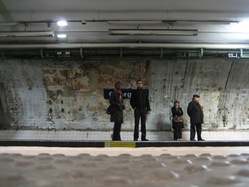
Warm weather is upon us, and here in Paris that signals the start of construction season. Seems like every street and park is suddenly being ripped up. Underground, though, in the subway tunnels of the Paris Métro, construction season has already been underway for months. Some two-thirds of the system’s 297 stations are undergoing renovation.
This is more than just a fresh coat of paint. Workers are steadily peeling back the skin of the stations’ walls, preparing to install an entirely new surface. This isn’t entirely good news.
No doubt the new stations will be easier (and cheaper) to clean and maintain, but their fresh white tiles introduce a monotonous consistency that threatens to flatten the whimsical design of many of the system’s stations.
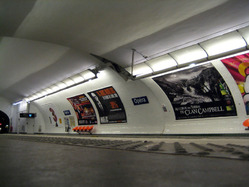
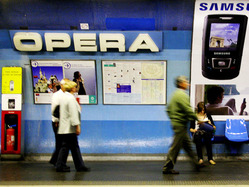
The vast Opéra station’s groovy blue tiles and retro typography, for example, were replaced this past winter with humdrum white walls. The seventies-swimming-pool sensibility of the original design created a funky design time capsule, now lost.
Another of my favorite stations, Franklin D. Roosevelt on the Champs Elysées, has also been gutted, currently in mid-construction. The old 1957 design featured back-lit glass bricks, orange and turquoise highlights, and bronze-lettered sans-serif typography. It’s another perfectly preserved specimen of its design period.
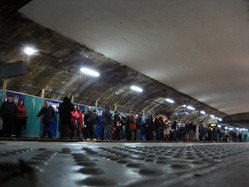
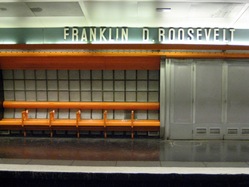
Well, okay, not so perfectly preserved. Both stations were fraying, their design facades deteriorating and in need of renovation. Alas, instead of simply refreshing these charming icons of the Métro’s design heritage, the state is ripping them out.
To be sure, a full-blown overhaul could be an opportunity, too, and maybe I’ll be surprised. After all, the designs of Opéra and Roosevelt were themselves the result of renovations in their day.
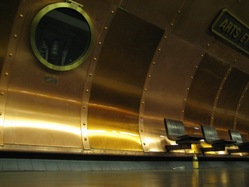
Several recent-vintage stations do feature remarkable designs. The frosted glass walls installed last year at the Champs Elysées Clémenceau station seem to shimmer and move as the train rolls by. The Jules-Verne-inspired design of the Arts et Métiers station transports you to a copper submarine beneath the streets of Paris. Every tile of the Concorde station has a letter spelling out the text of the La Déclaration des Droits de l’Homme et du Citoyen. And the Saint-Germain-des-Prés station features a rotating literary installation, with texts projected on the ceiling.
So who knows, maybe the Roosevelt station might yet get a shiny new look that will become a time capsule of our own design era. My fear, though, is that it will turn out like Opéra did: blank and devoid of character, a total surrender to expediency and cheap maintenance. Time will tell.
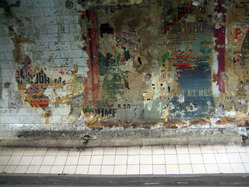
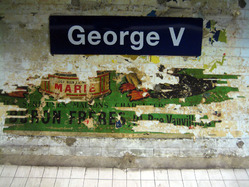
While we wait to find out, the construction work is surfacing other pieces of design treasure, only to destroy them just as quickly. When many of the stations saw their last renovation, now many decades ago, workers constructed a new wall in front of the existing wall, like a drop ceiling. As the new work proceeds, those walls are being torn down to reveal the original station behind, often still decorated with old schedules, subway maps and advertisements.
It’s a temporary and unintentional exhibition of urban archaeology and graphic-design history. The Independent published an article about these graphic-design artifacts a few weeks ago: “Some appear to date back to the earliest days of the Paris Métro a century ago. At the George V station on the Champs Elysées, there is even the ragged remains of a poster warning, in German, of the dangers of feindagenten (enemy agents) at work on the streets of Paris.”
I missed that particular poster on a recent spelunking trip through the Paris subway, but I did snap some photos of other remnants in the George V station, including a poster whose now-dismembered goose feet suggest an ad for foie gras. Another particularly ancient sign, painted directly on the tiles, advertised «machines électriques.»
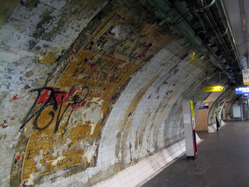
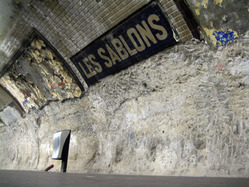
At other stations, even these original walls have been chipped away, turning the station into a kind of long skinny cave of rough stone. At the Sablons station, though, the work is halfway complete, which feels particularly tragic; the tiles and posters of the original station walls are slashed in half at chest height.
“Yes, many of these sites are extraordinary,” a spokeswoman for the agency that books Métro advertising told The Independent. “Unfortunately, there are no plans to preserve any of these old posters. The RATP are not poets. They are a public transport company and committed to their renovation programme.”





